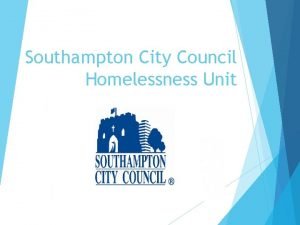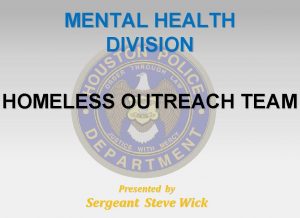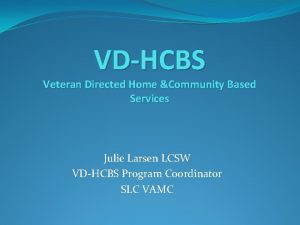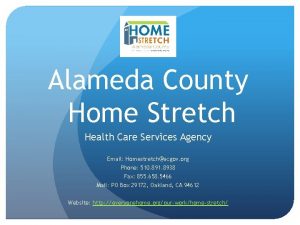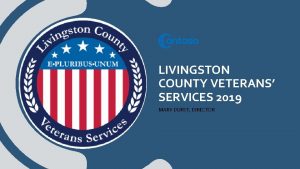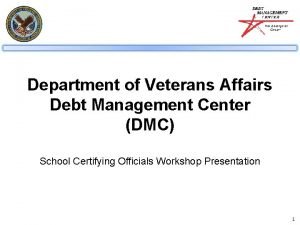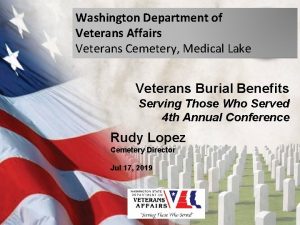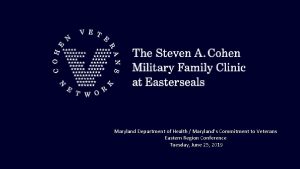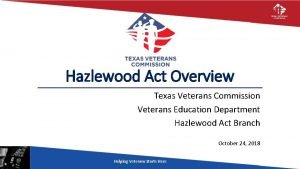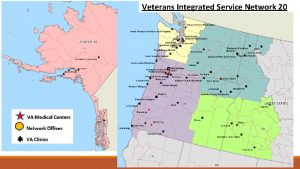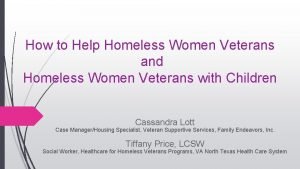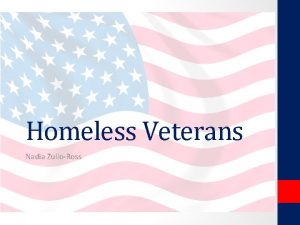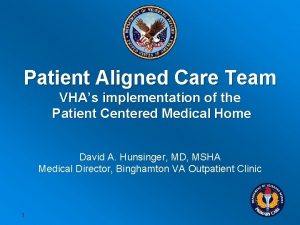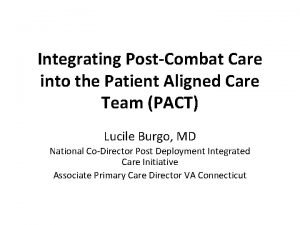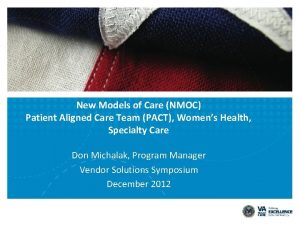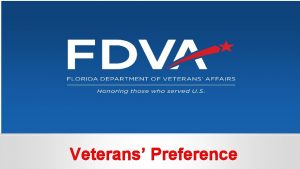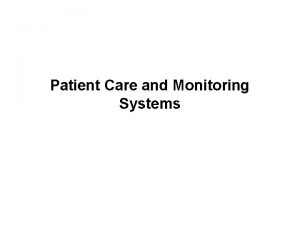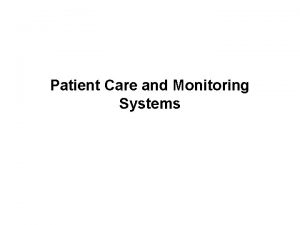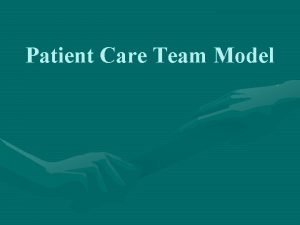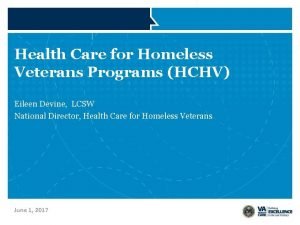Homeless Veterans Patient Aligned Care Team HPACT Office
















- Slides: 16

Homeless Veterans Patient Aligned Care Team (H-PACT) Office of Homeless Programs Office of Primary Care Operations December 2012

Background • Homeless Veterans have more chronic medical, mental health and substance abuse needs that are more difficult to treat in traditional care models and to coordinate within fragmented delivery systems. • Transportation and scheduling challenges, competing priorities, and services not aligned with their needs keep many homeless Veterans from accessing primary care and receiving services necessary to exit homelessness. • Homeless Veterans end up relying on emergency departments for care and are hospitalized at much higher rates than their housed counterparts. • Homeless Veterans are three to six times more likely to become ill than housed people and cost three times more to care for than non-homeless Veterans. VETERANS HEALTH ADMINISTRATION 2

Background • Integrated Primary Care-Homeless Services care models tailored to the needs and specific challenges of homeless Veterans have been able to: – – Reduce emergency department use by up to 40% Reduce hospitalizations by 30 -50% Improve chronic disease management outcomes Expedite housing placement and retention VETERANS HEALTH ADMINISTRATION 3

The Need for a Paradigm Shift How do we take advantage of health care seeking behavior and the “treatable moment” embedded in a health care episode? How can the resources and “safe haven” of the health care setting be used to break the cycle of homelessness and poor health? VETERANS HEALTH ADMINISTRATION 4

Homeless Patient Aligned Care Team • Program goal is creating a collaborative Homeless Programs. Primary Care model that eliminates barriers to quality health care and improves health and housing outcomes of Veterans that are homeless or at imminent risk of homelessness. • Not intended to replace care being provided or alter ongoing care relationships for those homeless Veterans engaged in treatment models (e. g. Severe Mental Illness (SMI), HIV care). VETERANS HEALTH ADMINISTRATION 5

H-PACT Model • Three different homeless-oriented primary care PACT models will be supported by this initiative for local station implementation. Model adoption will be based on sitespecific need, capacity, geography and targeted focus: – Co-located, integrated Homeless PACT. – PACT team enhanced with homeless case management. – Community Resource and Referral Center (CRRC)-based Homeless outreach/PACT. VETERANS HEALTH ADMINISTRATION 6

Health and Homelessness Health Care sites as “First Stops” for newly homeless The health encounter as a “treatable moment” for behavior change and treatment engagement Housing Security for Homeless Persons Health maintenance and support as a means of keeping people in housing

H-PACT Program • H-PACT’s must be able to: – Provide Accessible, Just-in-Time Continuity Care to homeless Veterans when and where they need it. – Respond to the “Treatable Moment” with staff trained and prepared to engage patients in behavior change, and with resources in place to act on patient motivation. – Create a care setting that promotes trust and relationship building necessary for longitudinal primary care and care coordination. – Address competing social and sustenance needs of the Veteran trying to access health services. – Employ a Rapid Engagement/Housing-First approach. VETERANS HEALTH ADMINISTRATION 8

H-PACT Goals • Deliverables: – Systems redesign – Population-Centered Homeless PACTs: – Rapid Access – Reduce barriers and obstacles to receiving care; bring homeless into care earlier in their homelessness. – Sustained Engagement – Provide ongoing, longitudinal care that responds to changing needs, interests and readiness of the Veteran. – Improved Clinical Outcomes for multi-morbid homeless Veterans – Improved Quality of Life – Provide comprehensive chronic disease and preventive care to a traditionally disenfranchised group – Greater Efficiencies in our care delivery system – Care Offsets – Reduce emergency department and hospital use; increase primary care, outpatient mental health, and substance abuse treatment. – Ending Veteran homelessness – Housing placement/stabilization – Integrate clinical care with housing objectives; partner with housing staff and community agencies. VETERANS HEALTH ADMINISTRATION 9

H-PACT Model for Treatment Engagement of Homeless Veteran Disengaged/Disenfranchised from Care Unstable sheltering Significant barriers to treatment engagement Health Care low among Maslow Hierarchy of needs High rates of ED and inpatient care Premature morbidity/mortality Treatment Engagement Housing First Stabilization Chronic disease management Facilitated access/population tailored care Prevent recidivism Care management of conditions Early identification new needs Leading to homelessness Perpetuating homelessness Delayed and deferred because of homelessness Address competing needs Identification and Referral Emergency Departments Intervention Homeless PACT Inpatient Wards Enhanced, open access Intensive case management Care tailored to population needs/de-stigmatizing care Community outreach/ Agency referrals One-stop care – On-site addressing of competing sustenance needs Disposition Homeless situation stabilized; transferred to general population PACT team w/ specialty care access Homeless situation not stabilized: Patient stays in Homeless PACT due to ongoing homelessness, imminent risk of return to homelessness Homeless situation stabilized; transferred to Special Population PACT based on patient need: SMI PACT Women’s Health PACT HIV PACT

H-PACT Program • Implementation Update – 37 sites funded to develop H-PACTs – 19 VISNs, 24 states, 20 in high impact/high volume cities, 7 in rural communities – Active engagement from Primary Care, Homeless and Mental Health programs VETERANS HEALTH ADMINISTRATION 11

Data Snapshot • 30 H-PACT sites are actively seeing homeless Veterans. • Over 4000 patients enrolled to date. Anticipated approximately 10, 000 will be enrolled by end of FY 2013. • H-PACT enrollment increasing by approximately 400 Veterans per month. • Most Veterans will stay in the H-PACT 12 to 18 months, depending on individual circumstances, preferences. VETERANS HEALTH ADMINISTRATION 5/25/2021 12

VISN Station VISN 1 Providence VAMC 4 Philadelphia VAMC 10 1 VA Connecticut Healthcare System (West Haven) VA Maine HCS (Togus) 4 VA Pittsburgh HCS 11 Battle Creek VAMC 20 Portland VAMC 5 VA Maryland HCS (Baltimore) 11 John D. Dingell VAMC (Detroit) 21 VA Northern California HCS VA Boston HCS (Causeway Street CBOC) Leeds VA Primary Care Center (New Bedford) 5 Washington DC VAMC 12 Jesse Brown VAMC (Chicago) 21 VA Pacific Islands HCS (Honolulu) 6 Hampton VAMC 16 21 San Francisco VAMC 2 Canandiagua VAMC 7 Ralph H. Johnson VAMC (Charleston) 16 22 VA San Diego HCS 3 Northport VAMC 7 Birmingham VAMC 17 22 VA Greater Los Angeles HCS 3 James J. Peters VAMC (Bronx) 8 James A. Haley VAMC (Tampa) 18 Micheal E. De. Bakey VAMC (Houston) Southeast Louisiana Veterans HCS (New Orleans) South Texas Veterans HCS (San Antonio) Phoenix VA HCS 22 VA Southern Nevada HCS 3 VA Hudson Valley HCS (Montrose) 9 Lexington VAMC 19 VA Eastern Colorado HCS (Denver) 23 Minneapolis VA HCS 23 Iowa City VA HCS 1 1 1 Station VISN Chalmers P. Wylie 20 VAMC (Columbus) Station VA Puget Sound HCS (Seattle) 13

Anticipated outcomes – Reduced emergency department visits, hospital admissions – Increased ambulatory care use (primary care, specialty, mental health, addictions) – Expedited housing/reduced recidivism – Improved chronic disease monitoring/management – Enhanced care, cost-efficiencies VETERANS HEALTH ADMINISTRATION 14 5/25 /202 1

H-PACT and Community Partners • Referral source • Development of partnerships • Collaborative effort to serve homeless Veterans VETERANS HEALTH ADMINISTRATION 15 15

Questions? For more information please contact: Rico Aiello, H-PACT Project Coordinator Riccardo. aiello@va. gov VETERANS HEALTH ADMINISTRATION 16 16
 Hpact
Hpact Street homeless prevention team southampton
Street homeless prevention team southampton Hpd homeless outreach team
Hpd homeless outreach team Department of veterans affairs office
Department of veterans affairs office Veterans directed home and community based care
Veterans directed home and community based care Vd hcbs
Vd hcbs Alameda county health care for the homeless
Alameda county health care for the homeless Level of care primary secondary tertiary
Level of care primary secondary tertiary Patient 2 patient
Patient 2 patient Veterans administration daytona beach
Veterans administration daytona beach Livingston county veterans services
Livingston county veterans services Goldman sachs veterans integration program
Goldman sachs veterans integration program Va debt waiver request letter sample
Va debt waiver request letter sample Medical lake veterans cemetery
Medical lake veterans cemetery Maryland commitment to veterans
Maryland commitment to veterans Tvc hazlewood
Tvc hazlewood Visn 20
Visn 20

